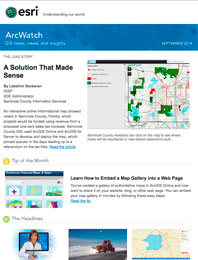
Dr. Este Geraghty first encountered GIS in college and soon became enamored with the technology that health professionals today use for everything from promoting fitness to tracking diseases such as Ebola.
Geraghty’s passion for GIS led her to Esri, where she recently joined the health and human services team as the industry manager. In her new role, Geraghty will articulate her vision for making geography a foundational component in health and human services as she represents Esri at events worldwide.
Even before arriving at Esri, Geraghty was a strong GIS advocate and spoke at many events. Esri marketing writer Robby Deming recently sat down to talk with her about her winding path toward Esri and about some of the new and existing fields within health and human services that she plans to focus on.
Deming: The recent Ebola outbreak in Africa has put disease tracking to the front of everyone’s mind. How can GIS make a difference in tracking and analyzing diseases such as Ebola?
Geraghty: GIS is a critical tool for epidemiologists and other health professionals focused on tracking and analyzing infectious diseases. Place is intrinsically tied to disease surveillance and transmission. We tend to quantify and communicate disease incidence and prevalence rates by place, and we use spatial analysis to understand the risk factors associated with disease. When emergencies arise, such as the Ebola outbreak in West Africa, using GIS for disease modeling can combine historical and current disease and environmental information. This helps us predict transmission patterns, analyze the environmental factors that encourage disease, and plan interventions.
Deming: You have an impressive resumé that spans several different roles and responsibilities. What did you do before you joined Esri?
Geraghty: I was a practicing physician in general internal medicine at the UC Davis Health System in Sacramento, California. I also served as the deputy director of the Center for Health Statistics and Informatics at the California Department of Public Health.
Deming: What did you do as deputy director?
Geraghty: Our group had two main functions: vital records and informatics. In terms of vital records, we managed California’s vital records systems covering the issuance, preservation, and registration of events such as birth, death, and marriage. With approximately 500,000 births per year in the state and 250,000 marriages and deaths per year each, we kept plenty busy.
For informatics, we were charged with helping to assist other programs throughout the agency with turning data into usable information. We also regularly published information on indicators such as low birth weights and causes of death. One of our biggest accomplishments was taking a leading role in the California Health and Human Services Agency to launch the first statewide open data portal for health. Overall, our vision was “usable data, effectively delivered.”
Deming: It seems that you have a love for data and information. Is that what brought you to GIS?
Geraghty: That’s definitely part of it. I actually first encountered GIS while completing my master’s degree in public health. I attended a lecture about GIS, and I was fascinated. When I started out in medicine, I originally wanted to be a radiologist. I’m a very visual person, and I love computers. GIS seemed to speak to both of those things. So I chose a capstone project that required the use of GIS and soon enrolled in an associate’s degree program at American River College to develop proficiency in GIS.
Deming: How do you view GIS in health and human services?
Geraghty: Among non-GIS users, many people think that incorporating geography in medicine is a new phenomenon, but there’s always been an intrinsic relationship between the two. John Snow, the nineteenth-century physician, is commonly thought to be the first person to marry health and GIS with his analysis of cholera and water pumps in England (to show the relationship between outbreaks of cholera in specific neighborhoods and the locations of pumps with potentially tainted water). But people had been using geography in health long before that. During the bubonic plague that decimated Europe, bureaucrats used maps to track outbreaks and containment areas. And going back even further, like about 900 AD, the physician Rhazes hung slabs of meat around what is now Baghdad to select a hospital site based on putrefaction rates, hypothesizing that slower putrefaction was associated with healthier environments. More recently, Dr. John E. “Jack” Wennberg made it clear that access to health care depends greatly on where you live. (Wennberg is an emeritus professor of the Dartmouth Institute who won the Making a Difference Award last year at the Esri User Conference for using GIS in a nationwide study of the geographic variation in medical care. He is founding editor of The Dartmouth Atlas of Health Care and author of the book Tracking Medicine: A Researcher’s Quest to Understand Health Care.)
As a physician, it’s obvious to me that you can’t tear apart place and health.
Deming: What do you want to focus on at Esri?
Geraghty: There’s a growing movement, the quantified self, where people are measuring their interaction with their environments, and we absolutely want to support that. We want to help people collect data and map things like walkability. We’ll continue to support efforts like epidemiology and geomedicine, and we’re increasingly going to focus on helping people and communities map their health resources. There are also a lot of business problems that hospitals and providers can address with GIS.
I’m actually also interested in pursuing applications of GIS in veterinary science. It’s a growing field that we haven’t explored much in the past. With the One Health movement that links animal, environmental, and human health, I think it’s an area that will become more important in the coming years. (One Health Initiative works toward improving the lives of both humans and animals by collaboration among those who work in veterinary medicine, human medicine, and the environmental sciences. According to the group’s website, this is important because there’s a strong link between the health of animals and humans—including the mental bond people have with animals and vice versa.
Deming: You were a practicing physician and the deputy director of a state agency. What brings you to Esri?
Geraghty: It sounds selfish, but I wanted to improve the reach of my message. As an academic physician, you’re lucky if 100 people cite your research. When I started working with the Department of Public Health, I was able to work with federal health and human services partners, which helped me extend the reach of my work a little farther. I truly feel like Esri gives me the opportunity to make a difference and effect greater change. At Esri, I get to be creative. I get to communicate. And I get to help shape the future vision for GIS in health while optimizing the way it’s currently used.
Looking back at my career, it seems clear to me that I was always on my way to Esri. It couldn’t be a better fit.
Deming: Thanks so much for your time. Do you have any parting thoughts about your overall goal in joining Esri?
Geraghty: My broad goal is that when I’m done, I won’t have to explain what GIS is to health and human services organizations. My hope is that, one day, the technology will be an integral part of the landscape. I want people to expect to find geography in health.
Dr. Geraghty earned her MD from the UC Davis School of Medicine, an MS from UC Davis, and an MPH from the UC Davis School of Medicine. She is board certified by the American Board of Internal Medicine and the American Board of Preventive Medicine.
